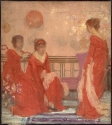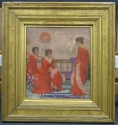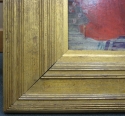The Paintings of James McNeill Whistler
YMSM 091
Harmony in Flesh Colour and Red

Date
Harmony in Flesh Colour and Red probably dates from between 1863 and 1867.

Harmony in Flesh Colour and Red, Museum of Fine Arts, Boston

Sketch for 'La Princesse du pays de la porcelaine', Worcester Art Museum
1863/1867: It is dated partly from the technique, and the Asian accessories, such as are seen in Whistler's work from 1863 on, in, for instance, La Princesse du pays de la porcelaine y050 and Variations in Flesh Colour and Green: The Balcony y056. The carpet is similar to that in Sketch for 'La Princesse du pays de la porcelaine' y049, which is thought to date from 1863/1864. However, the dresses suggest a slightly later date.

Two figures, Munson-Williams-Proctor Institute
1866/1868: A related drawing, Two figures m0311, has been roughly dated to between 1866 and 1868. The dress of the figures in this drawing and in Harmony in Flesh Colour and Red references contemporary dress of about 1867.

The White Symphony: Three Girls, Freer Gallery of Art
1867/1870: The setting, with rug and fans, has parallels in the 'Six Projects', particularly The White Symphony: Three Girls y087, which is dated 1867/1869. Andrew McLaren Young (1913-1975) suggested a date between 1867 and 1870, relating it to this and the other 'Six Projects'. 1
Images

Harmony in Flesh Colour and Red, Museum of Fine Arts, Boston

Harmony in Flesh Colour and Red, Museum of Fine Arts, Boston

Harmony in Flesh Colour and Red, frame detail

Harmony in Flesh Colour and Red, photograph, GUL Whistler PH4/9

Two figures, Munson-Williams-Proctor Institute

Sketch for 'La Princesse du pays de la porcelaine', Worcester Art Museum

The White Symphony: Three Girls, Freer Gallery of Art
Subject
Titles
Several possible titles have been suggested:
- 'Harmony in Flesh Color & Red' (ca 1881, Whistler). 2
- 'Three Ladies in Red, on a terrace' (1929, Christie's). 3
- 'Symphony in Red' (1946, Sotheby's) 4
- 'Symphony in Red' (1960, Arts Council). 5
- 'Harmony in Flesh Colour and Red' (1980, YMSM). 6
'Harmony in Flesh Colour and Red', Whistler's own title, is the preferred title.
In this catalogue raisonné Whistler's title or the first published title is retained, wherever possible. Whistler’s use of “flesh colour” to describe colour, as here, could imply a racist presumption that skin tone is defined as 'white' or Caucasian. In this case it describes the 'flesh-pink' of the models' skin, as opposed to any other skin colour, a pink that is echoed in their stoles, the blossom and background.
Description

Harmony in Flesh Colour and Red, Museum of Fine Arts, Boston
A figure composition in vertical format, showing three women in an interior. Two women are seated at left. They sit in slight three-quarter view to right, and have brown hair and coral red full-skirted dresses. The dress of the central woman has a low v-necked neckline; she carries a cream stole. Likewise, the standing woman at right, facing left, is in red with a long stole draping almost to the ground behind her. The walls of the room are pale peach pink, decorated with palm fans, above a panelled brown and cream dado. On the floor is a blue and white rug.

Harmony in Flesh Colour and Red, photograph, GUL Whistler PH4/9
There are early photographs of this painting in the Glasgow University Library, and the Lucas Collection, Baltimore, the latter inscribed by Whistler 'Harmony in Flesh Color & Red' and signed in the margin with a butterfly of about 1881. In these photographs the butterfly signature does not appear on the painting. This later signature is a little like the butterflies Whistler used in the mid-1880s, but it is in an unusual form, and rather small, and was probably not added by Whistler.
Technique
Composition

Two figures, Munson-Williams-Proctor Institute

Harmony in Flesh Colour and Red, Museum of Fine Arts, Boston
A related pen drawing Two figures m0311 shows the central, seated figure, while, on the left, instead of the other seated woman, there is a woman standing, seen from behind, in a similar costume, except for a narrower skirt.
Technique

Harmony in Flesh Colour and Red, Museum of Fine Arts, Boston
The canvas, nearly square, is in vertical format. It is freely and roughly painted, with vigorous brushstrokes in thick creamy paint. Five additional fans were drawn in crayon on the wall, overlapping with the painted ornaments. Only the face of the central figure is defined in any detail. There are numerous pentimenti, which suggest the central figure was painted before the woman on the left was added, and that the artist was in the process of changing the outlines of the figure on the right.
In addition, a number of vertical lines are visible under the figures, particularly under the skirt of the central woman and through the figure at right: these suggest that either there was a completely different composition underneath, or even that there was a landscape subject painted at right angles to the current work.
Conservation History

Harmony in Flesh Colour and Red, photo, GUL Whistler PH4/9
An early photograph from Whistler's collection shows that the butterfly was absent: it is a later addition by an unknown hand. The photographic process may have changed the apparent colour emphasis in the painting, but the brushstrokes look more or less the same as now.
Frame
- 1863/1867: the style and whereabouts of early frames, if any, are unknown.
- ca 1876: Flat Whistler frame, currently on the picture. 7

Harmony in Flesh Colour and Red, Museum of Fine Arts, Boston

Harmony in Flesh Colour and Red, frame detail
Since the early provenance of this painting is unknown, it is not clear if the current frame does actually date from the 1870s, or when it was added, or by whom.
History
Provenance
- 1929: sold by J. & W. Rosenheim & Co. at Christie's, London, 8 April 1929 (lot 105) as 'Three Ladies in Red, on a terrace', and bought by Neasson or Pearson, £12.1.6;
- Summer 1930: bought by the writer and collector Arthur Morrison (1863-1945), of High Beech, Essex;
- 1946: sold at auction by Sotheby's, London, 20 March 1946 (lot 241) as 'Symphony in Red', and bought by Roland, Browse & Delbanco, London dealers, for £390.0.0;
- 1946: bought by John Bryson (1896-1976), Oxford;
- 1960: bought from him through Durlacher, New York dealers, by the Museum of Fine Arts, Boston, for $12,000 (Emily Louisa Ainsley (b. 1847) Fund).
The provenance before 1929 is unknown.
Exhibitions
It was not exhibited in Whistler's lifetime.
Bibliography
Catalogues Raisonnés
- Young, Andrew McLaren, Margaret F. MacDonald, Robin Spencer, and Hamish Miles, The Paintings of James McNeill Whistler, New Haven and London, 1980 (cat. no. 91), plate 65, as 'Harmony in Flesh Colour and Red'.
- MacDonald, Margaret F., James McNeill Whistler. Drawings, Pastels and Watercolours. A Catalogue Raisonné, New Haven and London, 1995 (cat. no. 311).
Authored by Whistler
- None.
Catalogues 1855-1905
- None.
Journals 1855-1905
- None.
Monographs
- None.
Books on Whistler
- Way, Thomas Robert, Memories of James McNeill Whistler, the Artist, London and New York, 1912, drawing repr. f.p. 24.
Books, General
- Ono, Ayako, Japonisme in Britain: Whistler, Menpes, Henry, Hornel and nineteenth-century Japan, London, 2003, pp. 70-71, repr. fig. 2.22.
Catalogues 1906-Present
EXHIBITION:
- The Lyrical Trend in British Painting, Roland, Browse & Delbanco, London, 1946 (cat. no. 35) as 'Symphony in Red – An Interior with Three Girls'.
- Sweet, Frederick A. (ed.), Sargent, Whistler and Mary Cassatt, Art Institute of Chicago and Metropolitan Museum of Art, New York, 1954 (cat. no. 101).
- Young, Andrew McLaren, James McNeill Whistler: An Exhibition of Paintings and Other Works, Organized by the Arts Council of Great Britain and the English-Speaking Union of the United States, London and New York, 1960 (cat. no. 19) as 'Symphony in Red'.
- Reff, Theodore, and Allen Staley (eds), From Realism to Symbolism: Whistler and His World, Columbia University, New York, 1971 (cat. no. 21).
- Taynton, Carol (intro.), Whistler in New England Collections, [checklist], Boston, 1977 (no cat. number).
- Dorment, Richard, and Margaret F. MacDonald, James McNeill Whistler, Tate Gallery, London, Musée d’Orsay, Paris, and National Gallery of Art, Washington, DC, 1994-1995 (cat. no. 29).
- Warner, Malcolm, Anne Helmreich, and Charles Brock, The Victorians: British painting, 1837-1901, National Gallery of Art, Washington, DC, 1996, p. 185.
SALE:
- Christie's, London, 8 April 1929 (lot 105) as 'Three Ladies in Red, on a terrace'.
- Sotheby's, London, 20 March 1946 (lot 241) as 'Symphony in Red'.
Journals 1906-Present
- Anon., 'Shorter Notices: The Lyrical Trend in English Painting', The Burlington Magazine, vol. 88, May 1947, pp. 126, 128, repr. p. 126.
Websites
- Boston Museum of Fine Arts website at http://www.mfa.org.
Unpublished
- Revillon, Joseph Whistler, Draft Catalogue Raisonné of the Paintings of J. McN. Whistler, [ca 1945-1955], Glasgow University Library (cat. no. 261).
Other
- None.
Notes:
1: Young, A. McLaren, James McNeill Whistler, Arts Council Gallery, London, and Knoedler Galleries, New York, 1960 (cat. no. 19). It was dated 'about 1869' in YMSM 1980 [more] (cat. no. 91).
2: Photograph, G. A. Lucas Collection, Baltimore Museum of Art.
3: Christie's, London, 8 April 1929 (lot 105).
4: Sotheby's, London, 20 March 1946 (lot 241).
5: Young, A. McLaren, James McNeill Whistler, Arts Council Gallery, London, and Knoedler Galleries, New York, 1960 (cat. no. 19).
6: YMSM 1980 [more] (cat. no. 91).
7: Dr Sarah L. Parkerson Day, Report on frames, 2017.